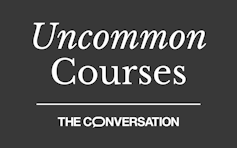This engineering course has students use their brainwaves to create performing art
- Written by Francesco Fedele, Associate Professor of Civil and Environmental Engineering, Georgia Institute of Technology

Why is this course relevant now?
Civil engineering can be explained and taught using the physics and mathematics of Isaac Newton and Gottfried Leibniz, from the 17th century: the concepts of derivatives and force being proportional to acceleration.
In our fast-changing world, there are exciting discoveries happening in science and technology, like in the understanding of the universe, artificial intelligence and quantum computing.
To prepare for the challenges posed by these recent discoveries, engineering students should be familiar with special mathematical tools developed by 20th-century geniuses such as Elie Cartan and Einstein. Such tools empower students to gain insights such as uncovering hidden geometric structures of complex physical systems or of large amounts of data. Normally, engineering classes don’t teach these topics.
The course also involves the participation of Colombian university students interested in arts for the RobotArts Initiative[13]. Such an international exchange seeks to increase the number of Latino engineering students with skills in the arts, engineering and robotics. Besides taking my course, the students from Colombia also take a course on robotics.
What’s a critical lesson from the course?
Students realize the mental health benefits[14] of practicing arts. They feel more self-confident and have more self-esteem[15] because they have created something.
Performing art live empowers students’ self-expression. By not relying on memorization, these performances stimulate spontaneous creativity, improvisation and free thinking.
What materials does the course feature?
• “Spacetime and Geometry: An Introduction to General Relativity,[16]” by Sean M. Carroll, Cambridge University Press, 2019 – a textbook that covers the foundations of the general relativity and mathematical formalism.
• “Einstein, Picasso: Space, Time, and the Beauty That Causes Havoc_[17] by Arthur J. Miller, Perseus Books Group, 2001 – a biography of Albert Einstein and Pablo Picasso.
• EEG headsets to acquire brainwaves and SuperCollider[18] software to synthesize them into music.
What will the course prepare students to do?
The course will prepare students to think like an artist, using abstraction, imagination and fluid thinking. They will tackle with confidence the new engineering quests and challenges of the 21st century. The challenges encompass sustainable urban and ocean infrastructure design for extreme weather, global warming mitigation, clean water and energy, quantum computing, cybersecurity and ethical use of AI[19].
References
- ^ Uncommon Courses (theconversation.com)
- ^ Picasso at the Lapin Agile (www.concordtheatricals.com)
- ^ Einstein, Picasso: Space, Time and the Beauty That Causes Havoc (www.arthurimiller.com)
- ^ Emily Vickers (www.createdbyemily.com)
- ^ Rachel Grant (www.rachelgrantstudio.com)
- ^ Anna Doll (research.gatech.edu)
- ^ Jerushia Graham (jerushiagraham.wixsite.com)
- ^ Mike Winters (mikewinters.io)
- ^ pencil and charcoal drawing (issuu.com)
- ^ oil painting (issuu.com)
- ^ Chris Lai (lai-etal-lab.github.io)
- ^ turbulence (www.youtube.com)
- ^ the RobotArts Initiative (www.100kstrongamericas.org)
- ^ mental health benefits (doi.org)
- ^ self-esteem (apps.who.int)
- ^ Spacetime and Geometry: An Introduction to General Relativity, (www.worldcat.org)
- ^ Einstein, Picasso: Space, Time, and the Beauty That Causes Havoc_ (www.arthurimiller.com)
- ^ SuperCollider (supercollider.github.io)
- ^ ethical use of AI (link.springer.com)
Authors: Francesco Fedele, Associate Professor of Civil and Environmental Engineering, Georgia Institute of Technology

